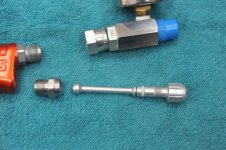rons
Diamond
- Joined
- Mar 5, 2009
- Location
- California, USA
Duplicating these two parts. The assembly is a air valve control on a paint gun handle.
The long screw is aluminum because of weight savings. This Sagola brand has the air caps
as all aluminum. In contrast a Devilbiss has a stainless air cap. Weight makes a difference
if your arm is at 90 degrees all the time ...

The stainless hex bushing will be drilled or bored and then run with a M9-1.0 tap D5.
The tap drill charts call out the size for the tap drills as 75% or 50% engagement.
For aluminum (75%) the drill would be 8mm. For stainless (50%) the drill would be 8.4mm.
Wear? I think the original aluminum screw is anodized and I have kept some silicone free grease on the threads.
How tight can a thread like this be until the hardness of the stainless becomes a wear factor on the anodize?
If the aluminum screw was not plated. A bad design?
The long screw is aluminum because of weight savings. This Sagola brand has the air caps
as all aluminum. In contrast a Devilbiss has a stainless air cap. Weight makes a difference
if your arm is at 90 degrees all the time ...

The stainless hex bushing will be drilled or bored and then run with a M9-1.0 tap D5.
The tap drill charts call out the size for the tap drills as 75% or 50% engagement.
For aluminum (75%) the drill would be 8mm. For stainless (50%) the drill would be 8.4mm.
Wear? I think the original aluminum screw is anodized and I have kept some silicone free grease on the threads.
How tight can a thread like this be until the hardness of the stainless becomes a wear factor on the anodize?
If the aluminum screw was not plated. A bad design?
Last edited:


